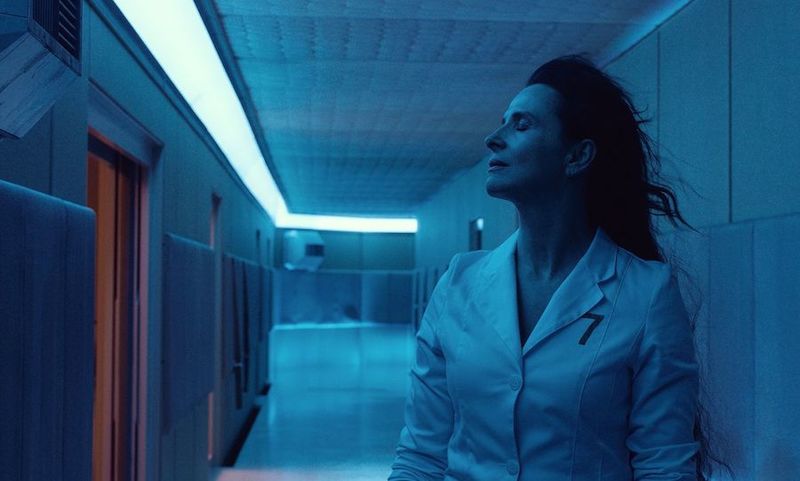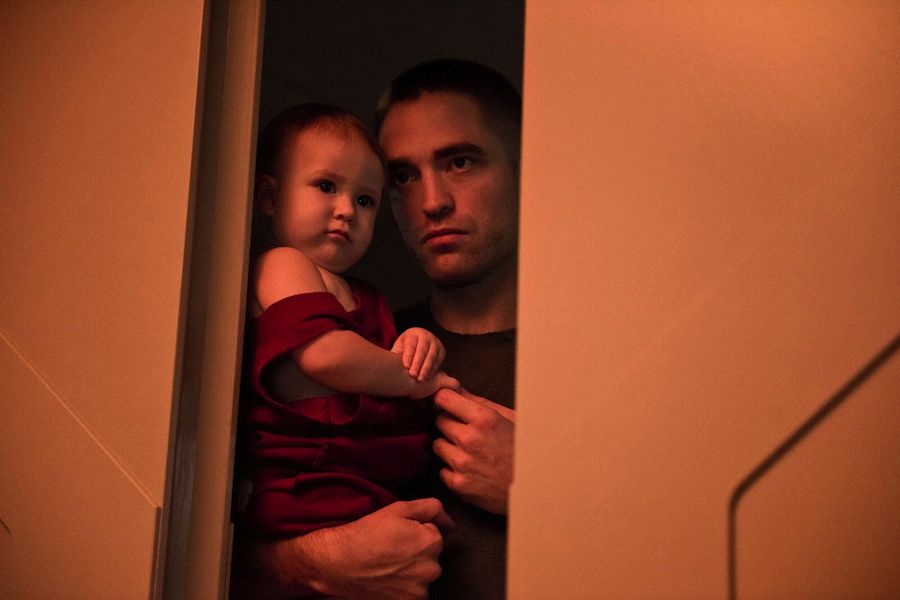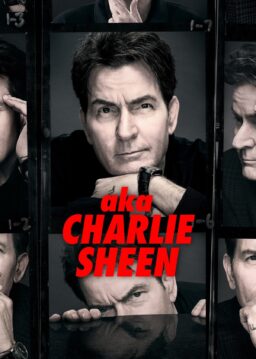Claire Denis may be one of the most revered auteurs in world cinema, but she has little interest or patience for such reverence. When I told the indelible French director that it was an honor to speak with her during our chat at Chicago’s Peninsula Hotel, she gave me a sideways glance and exclaimed, “The word, ‘honor,’ is too much! If I was Nelson Mandela, that would make sense, but I am making films.” I explained that the “honor” was derived simply from the opportunity to meet someone whose work had profoundly effected me. She paused thoughtfully before replying, “Films effect me profoundly, too, but making them is about luck more than honor. I take a slow U-turn from something that is entertainment to a project where I am able to put more of myself onscreen, and these days, it takes a lot of luck to be able to convince people that your films are worth making with the actors that you like.”
Needless to say, this initial exchange with Denis made me adore her all the more. She has the same sober perspective on life, freed of pretension, that has been a distinctive trait of her pictures from the very beginning. Her 1988 debut feature, “Chocolat”—not to be confused with Lasse Hallström’s 2000 romance of the same name starring Denis’ latest muse, Juliette Bincohe—is a masterpiece drawing upon the Paris-born filmmaker’s own childhood, where she spent many years living in Africa with her parents. Roger Ebert was an ardent champion of Denis throughout his career, leading the director to be honored with a Golden Thumb award last fall at Toronto International Film Festival’s annual Ebert luncheon. Watching Denis explore the realm of science-fiction in her latest triumph, “High Life,” I was reminded of a line from Ebert’s four-star review of “Chocolat,” where he describes how the land is so quiet “that thoughts can almost be heard,” and so patient “that every mistake is paid for sooner or later.” Denis told me that the critic’s words accurately captured why Africa is unlike any other place on earth.
“I remember looking at those landscapes when I was a young girl,” reflected Denis. “I could feel the beauty, the strength, the aliveness, but I also felt that I had better beware taking it for granted. When I came back to see my grandparents in France, they showed me the mountains in Brittany and said, ‘Don’t you see that this landscape is great?’ I disagreed and was disappointed, because it wasn’t vast. It’s not a place where every detail counts, it’s just nice. In France, there are a lot of nice landscapes, and I don’t mean that I am unable to see their beauty. But I know that it is not the same as when I was living in Africa and if I return there someday. When I am facing those landscapes, they are vast even in the mind, in the spirit. It’s not just a continent, it is the origin of the world.”
“High Life” portrays a different sort of expanse—the vastness of outer space—resulting in an absence of sound that may seem emptier yet is no less nuanced and revealing. In another bracingly audacious showcase, Robert Pattinson stars as Monte, a man who spends his days caring for his baby daughter, Willow, while stuck aboard an otherwise unpopulated ship cruising through deep space. Memories of his deceased crew mates, all former prisoners on death row, gradually reveal themselves, occasionally materializing to glimpse at him from nearby rooms, not unlike Dave observing his future self in “2001: A Space Odyssey.” Binoche plays the doctor leading the doomed mission, while Mia Goth proves as entrancing as ever in the role of a moody passenger who mocks Monte’s self-imposed isolation by singing, “Always alone, always blue…”

“It took a few days for us, the crew and the actors, to forget that we were on a set in Cologne, Germany, by the river Rhine,” admitted Denis. “But on the other hand, after three or four days, we realized that coming back to the hotel at night was a strange experience, since we had spent all day together in this little corridor. In Cologne, there is a space agency, [The European Astronaut Centre,] where you could meet the real guys who are going up to the space station. One of the cosmonauts told us that the first thing that struck him about his fellow passengers was how they smelled. They are so close together that they are able to identify each person by their own smell. The space station is projected on a screen twenty four hours every day, and I remember observing how they experience night and day. I also noticed that there was this guy always leaning and kneeling in the same spot, and I learned that he was the captain. I asked, ‘But what is he doing in that position every day?’ And I was told, ‘Because the toilet is blocked and not functioning, and he is the only one who knows how to repair it.’ I thought, ‘On top of everything, maybe there is the smell of shit!’ All of this creates a sort of feeling that is different from what you get with a landscape. The idea that what existed outside our ship was a void impacted each of us on the set. Even though we were in a studio draped in black, that idea of the void gave us such a strange feeling.”
As in Denis’ previous masterworks, the silences in “High Life” are so delicious that you savor every drop of them. The subtext that they conjure is all the more potent since it is never openly articulated. It doesn’t contradict the four-decade-old warning made by Ridley Scott’s “Alien” that “in space, no one can hear you scream,” yet that doesn’t prevent us from seeing how the the unlucky crew—confined on a ship ironically branded with the number seven—are often howling on the inside. Like the hypnotic first half of Andrea Arnold’s “Wuthering Heights,” Denis’ films somehow manage to convey the complexities of a novel through largely wordless visuals, knowing fully well that wall-to-wall narration would instantly cheapen their meaning. A lot has been written about the famous sequence in Denis’ 2008 gem, “35 Shots of Rum,” where the growth of key characters is noted by their movement on the dance floor, yet there are countless moments throughout the director’s career that are equally sublime. Take, for example, the moment in “Chocolat” when a white woman, Aimée (Giulia Boschi), locks eyes with her black houseboy, Protée (Isaach De Bankolé), while glancing at their reflection in a mirror. The layers of tension and eroticism that reverberate within their shared gaze could fill an entire chapter, and the actors radiate the full extent of their characters’ inner lives without having to utter a single line of dialogue. I asked Denis what she looks for in an actor that affirms their ability to—as she once said of Isabelle Huppert—“bring words to life with their body.”
“Of course, it is their talent, but it also may be their trust,” noted Denis. “Without trust, it is difficult for an actor or an actress to express very much with the body. If they know what I’m expecting and if they trust me enough, then they are able to move freely, expressing their character through the movement, whether it’s Juliette as the doctor, or Mia Goth being infuriated all the time, or Robert trying to protect himself and yet, being full of rage in the flashback at the beginning.”
Though the dialogue in “High Life,” Denis’ first film in English, may be occasionally difficult to make out—causing me to eagerly await the subtitled Blu-ray edition—the director specified in the film’s production notes that there was a clear reason behind her selection of language. She wanted the “American English” to lead the viewer to “recall a country where the death penalty still exists—like in certain states in the U.S.”
“In space, you speak either Russian or American, that is it,” Denis told me. “There was one Scottish cosmonaut I met in Cologne, and he has a strong Scottish accent, but he speaks like an American because the words are very important. It’s communication. You cannot play around speaking a little bit of Italian or a little bit of French, though I think that the cosmonauts are already beginning to learn Chinese. But I was interested in the idea of using people on death row as lab rats in a way that almost appears generous. The death corridor is horrible, so we give you another opportunity, an option, a glorious mission. This doesn’t happen in real life, of course, but I don’t think it’s impossible, considering how many things we are always trading—‘give me this and I give you that.’ I was in Texas a long time ago, near a place where there was a big penitentiary, and I read in the local newspaper that the cost of death row was so high that the people in this small city thought those inmates sentenced could be used for something useful rather than just be kept alive at the cost of the people.”

It’s fascinating to see Pattinson cast here as a character who believes “chastity has made him stronger,” since he initially gained global popularity for his lead role in the “Twilight” franchise, a saga built largely around the pangs of teenage abstinence. Of course, sex ed classes in the U.S. still favor abstinence education over any in-depth discussion of intercourse, let alone pleasure. Perhaps that is why the scene in “High Life” where Bincohe mounts a chair—much like she mounted Pattinson in “Cosmopolis”—and writhes with orgasmic ecstasy thanks to a phallus protruding from the contraption struck me as uncommonly moving. Denis said she was moved by the scene too, and likes that it stands as a rebuke to the stigma so often attributed to female sexuality.
“I would never have forced Juliette to do the scene, so she knew what to expect going in,” stressed Denis. “We made that scar on her stomach and she felt free with only me and Yorick Le Saux, the DP, in the room with her. It was really impressive the way she did it, and Stuart Staples had already composed the music, so we had it playing while filming the scene. I was surprised when I first heard the music of the so-called Fuckbox, because it wasn’t what I had expected. But then, when I realized that it came from a very deep place, I was like, ‘Wow, this is the right music, for sure.’ With Stuart’s work, I am always surprised in a great way.”
Another member of Denis’ crew worthy of being singled out is Pierre Buffin, a visual effects supervisor who has mastered the art of realizing the visions of such risk-takers as Gaspar Noé (“Enter the Void”) and David Lynch (“Twin Peaks: The Return”). The space imagery he creates in “High Life” is both convincing enough to suspend our disbelief and expressionistic enough to serve as an externalized abstraction of character psychology.
“Today in The New York Times, they have apparently published the first image of a black hole,” revealed Denis. “This is a place not too far off in the Milky Way, where we knew there would be a lot of them, but they’ve now become clearer and clearer. In the process of doing the film, we got more information about black holes and now, so many of these theories about them have become real knowledge. It’s not superstition anymore, and that’s great. While researching space myself, I viewed a [simulation] made by NASA of a possible faraway, very big black hole. I looked at the design—with those stars turning around, attracted—and I said, ‘Wow, it really looks like a crocodile eye.’ When they made the picture, there was probably some sort of cloud in the void, and I kept it in mind when talking with Pierre Buffin. I don’t think he was so happy working on the film because we had a very limited budget. Sometimes it was hard for him to accomplish what he had to do with little money, but I was happy with the project. I was not wanting so much more than what we had.”
The room where Denis and I were seated was located on the hotel’s fourteenth floor, and I noticed that she had left the window open in order to hear the strike unfolding on the streets below. “It was sad because no one was stopping to talk to them,” Denis said to me before we began the interview. “I felt like telling them, ‘Yes! We strike in France all the time!’” The youthful exuberance emanating from her eyes reminded me of the young girls in her films who are uncorrupted by the taboos of adulthood. There is a clear line that can be drawn from Willow in “High Life” all the way back to Aimée’s daughter, France (Cécile Ducasse), in “Chocolat,” whose tender yet unsentimental scenes with Protée are among the most touching in Denis’ oeuvre. Monte may worry that Willow’s harsh cries will kill him, yet she proves to be his ultimate reason to keep living.

“I think that Willow, growing from a baby and into a young woman, gives her father a sort of happiness or life he apparently would never have had without her, during his childhood or his time in juvie,” said Denis. “It’s as if life has been cut away from him, and suddenly this little girl brings him love, something he probably was not expecting. And she is very free with that, because of course, she has no one else.”
Willow’s determination to bring her father, quite literally, into the light mirrors the modern movements founded by youth, particularly the survivors of the Parkland school shooting. It was their impassioned fight for gun control that inspired a girl in Sweden, Greta Thunberg, to lead global protests to combat climate change. I asked Denis whether she saw the real-life heroism of these young people reflected in the character of Monte’s daughter.
“Yes, she is not afraid,” agreed Denis, before turning her attention to another topical movement. “I recently read in the newspaper that people in California are asking for the end of the death penalty. I understand why it exists. If I was hurt, I would like to be violent myself, but the death penalty solves nothing. It’s a fake way to solve the brutality of violence. I am speaking for France, where the death penalty is abolished, but treating violent people is not an easy thing to do, and it has not been solved. It should be taken into consideration that there should be more options for how to deal with people on death row.”
A compliment that Denis warmly received from me, albeit with a giggle, was my belief that she has directed some of the greatest child performances in cinema, beginning with Ducasse in “Chocolat,” whose unmannered maturity and vulnerability is on par with that of Linda Manz in “Days of Heaven.” When I mentioned that “Chocolat” remains Ducasse’s only credited film role, I was delighted that Denis leapt at the chance to share the one-time actress’s current whereabouts.
“She is a veterinarian, she has two kids and she now lives in France near Lyon,” said Denis with a smile. “And she rides horses. She is the same, but she is a woman. I also remember the baby in ‘Nenette and Boni,’ who was four days old. To watch a newborn baby is [akin to] watching science fiction. It’s really amazing to see life like that contained in such a small body, like when you are a child and you have a kitten. You are seeing life in a free way, which is something that you don’t see in your parents or your teacher, for instance. I have no trick when it comes to directing children. I just love to do it. And Robert was also very helpful. He was great with that little baby. When she made her first steps, they are what you see in the film. We were so moved.”












